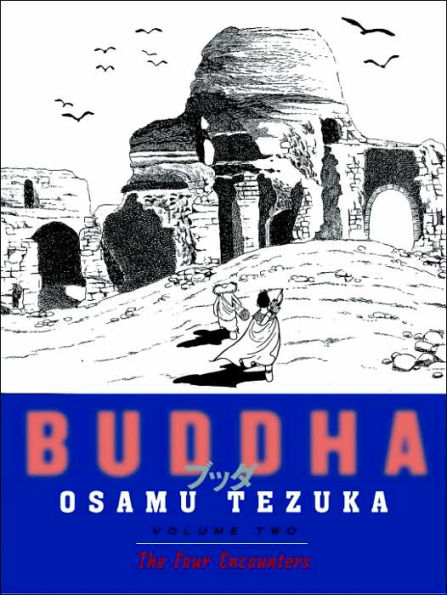Osamu Tezuka’s vaunted storytelling genius, consummate skill at visual expression, and warm humanity blossom fully in his eight-volume epic of Siddhartha’s life and times. Tezuka evidences his profound grasp of the subject by contextualizing the Buddha’s ideas; the emphasis is on movement, action, emotion, and conflict as the prince Siddhartha runs away from home, travels across India, and questions Hindu practices such as ascetic self-mutilation and caste oppression. Rather than recommend resignation and impassivity, Tezuka’s Buddha predicates enlightenment upon recognizing the interconnectedness of life, having compassion for the suffering, and ordering one’s life sensibly. Philosophical segments are threaded into interpersonal situations with ground-breaking visual dynamism by an artist who makes sure never to lose his readers’ attention.
Tezuka himself was a humanist rather than a Buddhist, and his magnum opus is not an attempt at propaganda. Hermann Hesse’s novel or Bertolucci’s film is comparable in this regard; in fact, Tezuka’s approach is slightly irreverent in that it incorporates something that Western commentators often eschew, namely, humor.
Osamu Tezuka’s vaunted storytelling genius, consummate skill at visual expression, and warm humanity blossom fully in his eight-volume epic of Siddhartha’s life and times. Tezuka evidences his profound grasp of the subject by contextualizing the Buddha’s ideas; the emphasis is on movement, action, emotion, and conflict as the prince Siddhartha runs away from home, travels across India, and questions Hindu practices such as ascetic self-mutilation and caste oppression. Rather than recommend resignation and impassivity, Tezuka’s Buddha predicates enlightenment upon recognizing the interconnectedness of life, having compassion for the suffering, and ordering one’s life sensibly. Philosophical segments are threaded into interpersonal situations with ground-breaking visual dynamism by an artist who makes sure never to lose his readers’ attention.
Tezuka himself was a humanist rather than a Buddhist, and his magnum opus is not an attempt at propaganda. Hermann Hesse’s novel or Bertolucci’s film is comparable in this regard; in fact, Tezuka’s approach is slightly irreverent in that it incorporates something that Western commentators often eschew, namely, humor.

Buddha, Volume 2: The Four Encounters
411
Buddha, Volume 2: The Four Encounters
411Related collections and offers

Product Details
| ISBN-13: | 9781932234572 |
|---|---|
| Publisher: | Kodansha USA |
| Publication date: | 07/11/2006 |
| Series: | Buddha Series , #2 |
| Pages: | 411 |
| Sales rank: | 182,261 |
| Product dimensions: | 6.05(w) x 8.03(h) x 1.22(d) |
| Age Range: | 13 - 17 Years |
About the Author
Customer Reviews
Explore More Items
Learn all about your favorite Wizarding World
This undated weekly planner notepad features iconic anime style imagery of beloved Harry Potter and
A special new edition in celebration of the 20th anniversary of the publication of Harry
Pagford is, seemingly, an English idyll, with a cobbled market square and an
This edition of Harry Potter and the Prisoner of Azkaban has a gorgeous new cover illustration by Kazu Kibuishi. Inside is the full text of the original novel, with decorations by Mary
This special edition of Harry Potter and the Order of the Phoenix has a gorgeous new cover illustration by Kazu Kibuishi. Inside is the full text of the original novel, with decorations by Mary
“Part thriller, part magical realism, and part social commentary, Indian Killer . . . lingers long past the final page.”— Seattle Weekly
A national best seller, Indian Killer is
Bestselling author Sherman Alexie tells the story of Junior, a budding cartoonist growing up on the Spokane Indian Reservation. Determined to take his future into his own hands, Junior leaves his
